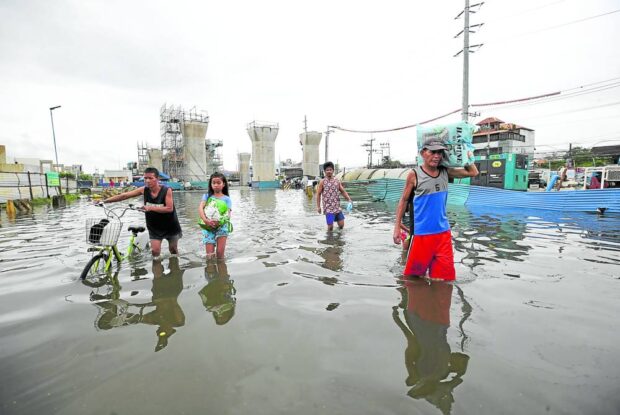Egay destroys P1.3 billion worth of agricultural products
Egay destroys P1.3B worth of agricultural products Inquirer.net


Typhoon Egay Wipes Out P1.3 Billion Worth of Agricultural Products

MORE FLOODS | Residents in Marilao town in Bulacan province wade through its flooded streets near pillars for the overhead MRT 7 rail line on Saturday. The weather bureau warns of more rains in the coming days from Tropical Storm “Falcon” (international name: Khanun), which is now east of Luzon over the Philippine Sea. (Photo by LYN RILLON / Philippine Daily Inquirer)
The Department of Agriculture (DA) announced on Saturday that Typhoon Egay (international name: Doksuri) has caused the destruction of P1.3 billion worth of agricultural products in Luzon and Visayas within a week.
Impact on Livelihood
The typhoon has severely affected the livelihood of 91,268 farmers and fisherfolk in the affected areas, resulting in a volume of production loss of 62,259 metric tons across 98,969 hectares of agricultural lands.
The increase in damage is attributed to updated reports from Cordillera Administrative Region, Ilocos Region, Cagayan Valley, Western Visayas, and Central Luzon.
Destruction of Crops and Facilities
Typhoon Egay has destroyed rice, corn, high-value crops, livestock, poultry, agricultural facilities, and fishing paraphernalia.
Corn accounted for 47.5 percent of the total damage, amounting to P648.2 million. It affected 38,401 metric tons of corn produce in 58,497 hectares of land.
Rice followed with P486.8 million in damages, equivalent to a share of 35.7 percent. High-value crops incurred P182.4 million in damages, accounting for 13.3 percent of the total.
Agricultural infrastructures sustained P20.8 million in damage, fisheries P14.1 million, and livestock and poultry P11.9 million.
Comparison to Previous Damage
The impact of Typhoon Egay on the farm sector is nearing the P1.3 billion damage caused by the low-pressure area, Intertropical Convergence Zone, shear line, and northeast monsoon (amihan) earlier this year.
Price Impact
Despite the escalating losses due to the typhoon, the Department of Agriculture assures that it won’t affect retail prices and supply of food items since the planted crops were in the early growth stage.
As of Friday, the price of a kilogram of local commercial rice ranged from P37 to P60, compared to last year’s range of P38 to P50. Imported rice retailed from P42 to P58 per kg, while imported regular milled rice was not available.
Milkfish (bangus) is being sold from P140 to P240 per kg, compared to P160 per kg a year ago. Tilapia is priced from P105 to P160 per kg, while local round scad (galunggong) is sold from P220 to P260 per kg. Imported round scad is priced at P200 per kg, and Indian mackerel (alumahan) is not available.
Bittergourd (ampalaya) is priced from P90 to P140 per kg, while eggplant reached P70 to P120 per kg. Cabbage ranged from P100 to P160 per kg.
Related Stories
- Falcon looms as PH still reels from Egay
- DSWD vows emergency cash programs for Egay-affected families
- 14 reported dead, over 21,000 displaced due to Egay, southwest monsoon
Conclusion
Typhoon Egay has caused significant damage to the agricultural sector, resulting in the loss of P1.3 billion worth of agricultural products. This has greatly affected the livelihood of farmers and fisherfolk in Luzon and Visayas. The destruction of crops, livestock, and agricultural facilities has led to a substantial decrease in production. However, the Department of Agriculture assures that it won’t have a significant impact on retail prices and food supply. Efforts must be made to support the affected communities and work towards achieving the Sustainable Development Goals (SDGs) related to zero hunger, sustainable agriculture, and climate action.
SDGs, Targets, and Indicators
-
SDG 1: No Poverty
- Target 1.5: By 2030, build the resilience of the poor and those in vulnerable situations and reduce their exposure and vulnerability to climate-related extreme events and other economic, social, and environmental shocks and disasters.
- Indicator: Not mentioned in the article.
-
SDG 2: Zero Hunger
- Target 2.3: By 2030, double the agricultural productivity and incomes of small-scale food producers, in particular women, indigenous peoples, family farmers, pastoralists, and fishers, including through secure and equal access to land, other productive resources and inputs, knowledge, financial services, markets, and opportunities for value addition and non-farm employment.
- Indicator: The article mentions that Typhoon Egay wiped out P1.3 billion worth of agricultural products, affecting 91,268 farmers and fisherfolk.
-
SDG 8: Decent Work and Economic Growth
- Target 8.5: By 2030, achieve full and productive employment and decent work for all women and men, including for young people and persons with disabilities, and equal pay for work of equal value.
- Indicator: Not mentioned in the article.
-
SDG 11: Sustainable Cities and Communities
- Target 11.5: By 2030, significantly reduce the number of deaths and the number of people affected and substantially decrease the direct economic losses relative to global gross domestic product caused by disasters, including water-related disasters, with a focus on protecting the poor and people in vulnerable situations.
- Indicator: The article mentions that Typhoon Egay caused P1.3 billion worth of damage to agricultural facilities and fishing paraphernalia.
-
SDG 13: Climate Action
- Target 13.1: Strengthen resilience and adaptive capacity to climate-related hazards and natural disasters in all countries.
- Indicator: The article mentions that Typhoon Egay caused significant damage to agricultural lands and infrastructure.
Table: SDGs, Targets, and Indicators
| SDGs | Targets | Indicators |
|---|---|---|
| SDG 1: No Poverty | Target 1.5 | Not mentioned in the article |
| SDG 2: Zero Hunger | Target 2.3 | The article mentions that Typhoon Egay wiped out P1.3 billion worth of agricultural products, affecting 91,268 farmers and fisherfolk. |
| SDG 8: Decent Work and Economic Growth | Target 8.5 | Not mentioned in the article |
| SDG 11: Sustainable Cities and Communities | Target 11.5 | The article mentions that Typhoon Egay caused P1.3 billion worth of damage to agricultural facilities and fishing paraphernalia. |
| SDG 13: Climate Action | Target 13.1 | The article mentions that Typhoon Egay caused significant damage to agricultural lands and infrastructure. |
Behold! This splendid article springs forth from the wellspring of knowledge, shaped by a wondrous proprietary AI technology that delved into a vast ocean of data, illuminating the path towards the Sustainable Development Goals. Remember that all rights are reserved by SDG Investors LLC, empowering us to champion progress together.
Source: newsinfo.inquirer.net

Join us, as fellow seekers of change, on a transformative journey at https://sdgtalks.ai/welcome, where you can become a member and actively contribute to shaping a brighter future.







